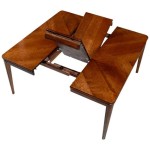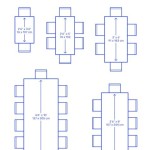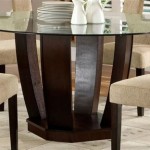Formal Dining Room Table Decorations: Elevating the Dining Experience
The formal dining room serves as a focal point in many homes, representing a space dedicated to special occasions, family gatherings, and more elaborate meals. The table within this room is not merely a functional surface; it’s a canvas for creating ambiance and reflecting personal style. Consequently, the decoration of a formal dining room table requires careful consideration to harmonize aesthetics with functionality and practicality. Attention to detail in selecting linens, centerpieces, tableware, and lighting contributes significantly to elevating the dining experience from ordinary to memorable.
The impact of well-chosen table decorations extends beyond mere visual appeal. It sets the tone for the event, influencing the mood and encouraging conversation. A beautifully adorned table demonstrates care and attention to detail, signaling to guests that the occasion is valued and worthy of celebration. The design should not only be aesthetically pleasing but also functional, allowing for ease of interaction and unobstructed views. Proper planning and execution are key to creating a space that is both elegant and comfortable.
Linens: The Foundation of Formal Table Setting
Linens form the foundation of any formal dining room table setting. A tablecloth is typically the first layer, providing a backdrop for the remaining elements. The choice of fabric, color, and pattern is crucial. White or ivory linen tablecloths are classic choices, exuding elegance and sophistication. They offer versatility, allowing for the incorporation of various color schemes and decorative accents. Alternatively, damask or jacquard fabrics can introduce subtle patterns and textures, adding depth without overwhelming the overall design. Regardless of the fabric chosen, ensuring the tablecloth is properly ironed and free of wrinkles is paramount for maintaining a polished appearance.
Beyond the tablecloth, the selection of napkins also plays a vital role. Linen napkins are the standard for formal settings, offering a luxurious feel and superior absorbency compared to paper alternatives. Napkins can be folded in a variety of decorative ways, adding a touch of personalization. Common folds include the classic pyramid, the bishop's hat, and the simple rectangle. Napkin rings can further enhance the presentation, providing an opportunity to introduce metallic accents or thematic elements. When selecting napkin rings, it is important to consider the overall aesthetic of the table and choose designs that complement the other decorations.
Placemats and runners can also be incorporated into the linen arrangement. Placemats provide individual settings for each guest, protecting the tablecloth from spills and adding visual interest. Runners can be placed down the center of the table, serving as a focal point and unifying element. When using both placemats and a runner, it is important to ensure that they coordinate in color and style. For instance, a runner in a contrasting color can create a striking visual effect against a neutral tablecloth and placemats.
Centerpieces: Creating Visual Interest and Focal Points
The centerpiece is arguably the most prominent decorative element on a formal dining room table. It serves as a focal point, drawing the eye and establishing the overall theme of the setting. The selection of a centerpiece should be carefully considered, taking into account the size of the table, the occasion, and the desired aesthetic. A well-chosen centerpiece should be visually appealing without obstructing views or hindering conversation.
Floral arrangements are a popular choice for centerpieces, offering a natural and elegant touch. The type of flowers, their color, and their arrangement can be tailored to suit the occasion. For example, a formal dinner party might feature a cascading arrangement of white roses and hydrangeas, while a holiday gathering could incorporate seasonal foliage and berries. The height of the floral arrangement is crucial; it should be low enough to allow guests to see each other across the table without strain. Alternatively, tall, slender arrangements can be used if they are designed in a way that allows for unobstructed views beneath them.
Beyond floral arrangements, there are numerous other options for creating unique and eye-catching centerpieces. Candelabras, either traditional or modern in design, can add a touch of glamour and sophistication. The glow of candlelight creates a warm and inviting atmosphere, enhancing the dining experience. Alternatively, a collection of decorative objects, such as sculptures, vases, or antique pieces, can be arranged to create a visually interesting tableau. When using multiple objects, it is important to consider their scale and placement, ensuring that they are balanced and harmonious. Natural elements, such as branches, stones, or shells, can also be incorporated into a centerpiece to add texture and visual interest. These elements can be arranged in a vase or on a tray, creating a natural and organic feel.
Thematic centerpieces are particularly effective for special occasions. For a holiday dinner, a centerpiece featuring seasonal decorations, such as pumpkins, gourds, or ornaments, can add a festive touch. For a birthday celebration, a centerpiece featuring balloons, candles, or personalized decorations can create a celebratory atmosphere. The key to creating a successful thematic centerpiece is to ensure that it is cohesive and well-executed, reflecting the spirit of the occasion.
Tableware: Harmonizing Functionality with Aesthetics
The tableware on a formal dining room table encompasses the plates, cutlery, glassware, and serving dishes. The selection of tableware should not only be aesthetically pleasing but also functional, providing guests with the necessary tools for enjoying their meal. The type of tableware used will depend on the formality of the occasion and the menu being served. However, regardless of the specific choices, it is important to ensure that the tableware is of high quality and in good condition.
Fine china is the standard for formal dining, offering a level of elegance and sophistication that is unmatched by other types of tableware. China patterns can range from simple and understated to elaborate and ornate, allowing for a wide range of aesthetic choices. When selecting a china pattern, it is important to consider the overall style of the dining room and the existing décor. A classic white china pattern is a versatile choice, pairing well with a variety of linens and centerpieces. Alternatively, a china pattern with a subtle border or motif can add a touch of visual interest without overwhelming the setting.
Silverware plays a crucial role in the formal table setting. A complete set of silverware typically includes a dinner fork, salad fork, soup spoon, dinner knife, and teaspoon. Additional pieces, such as dessert forks and spoons, may be added depending on the menu. The placement of silverware is governed by specific etiquette guidelines, with forks placed to the left of the plate, knives to the right, and spoons to the right of the knives. The specific arrangement can vary depending on the number of courses being served. Silverware should be polished and free of tarnish to maintain a polished appearance.
Glassware is another essential element of the formal table setting. A complete set of glassware typically includes a water glass, a wine glass for red wine, and a wine glass for white wine. Additional glasses, such as champagne flutes or cordial glasses, may be added depending on the beverages being served. The type of glassware used should be appropriate for the beverages being served, with stemmed glasses being preferred for wine and champagne. Glassware should be clear and free of water spots or smudges to ensure a pristine appearance.
Serving dishes are used to present food to guests at the table. They should be chosen to complement the other tableware in terms of style and material. Serving dishes can range from platters and bowls to tureens and gravy boats. The size and shape of the serving dishes should be appropriate for the type of food being served. Serving dishes should be arranged on the table in a way that is both aesthetically pleasing and functional, allowing guests to easily access the food.
Lighting: Setting the Mood and Enhancing Ambiance
Lighting plays a critical role in setting the mood and enhancing the ambiance of a formal dining room. The type of lighting used can significantly impact the overall dining experience, influencing how guests perceive the food, the décor, and each other. Proper lighting should be both functional and aesthetically pleasing, providing adequate illumination while creating a warm and inviting atmosphere.
Chandeliers are a classic choice for dining room lighting, providing a focal point and a sense of elegance. Chandeliers can range from traditional crystal designs to more modern and minimalist styles. The size and style of the chandelier should be appropriate for the size and style of the dining room. The height of the chandelier should be adjusted so that it provides adequate illumination without obstructing views or creating glare. Dimmable chandeliers are particularly desirable, allowing for the adjustment of light levels to suit the occasion.
Candlelight is another effective way to create a warm and intimate atmosphere in the dining room. Candles can be placed on the table as part of the centerpiece, or they can be arranged on side tables or mantels. The type of candles used can vary depending on the desired aesthetic, with taper candles and pillar candles being popular choices. Candleholders should be chosen to complement the other décor in the room. When using candles, it is important to take safety precautions, ensuring that they are placed away from flammable materials and that they are never left unattended.
Sconces can be used to provide supplemental lighting in the dining room. They can be mounted on the walls to provide ambient lighting or to highlight specific features, such as artwork or architectural details. Sconces can also be used to create a more intimate and romantic atmosphere. The style of the sconces should be chosen to complement the other lighting fixtures in the room.
Recessed lighting can be used to provide general illumination in the dining room. It is a discreet and versatile option that can be used to supplement other types of lighting. Recessed lighting can be used to highlight specific areas of the room or to create a more even distribution of light. The type of recessed lighting used should be chosen to complement the other lighting fixtures in the room.
The color temperature of the light is also an important consideration. Warm light, with a color temperature of around 2700K, creates a cozy and inviting atmosphere. Cool light, with a color temperature of around 5000K, provides a brighter and more energetic feel. The choice of color temperature will depend on the desired mood and the specific use of the dining room.

10 Formal Dining Room Ideas From Top Designers

Dining Room Table Decor Ideas How To Decorate Your

10 Formal Dining Room Ideas From Top Designers

25 Elegant Dining Table Centerpiece Ideas Room Traditional

85 Best Dining Room Ideas Designer

Before After Formal Dining Room Ideas Decorilla

Top 100 Home Decor Pics Club Formal Dining Room Beautiful Rooms Elegant

25 Formal Dining Room Ideas Design Photos Decor Rustic Table Centerpieces

14 Formal Dining Room Decor Ideas Pictures Rugs Direct

100 Stunning Designer Dining Room Ideas








